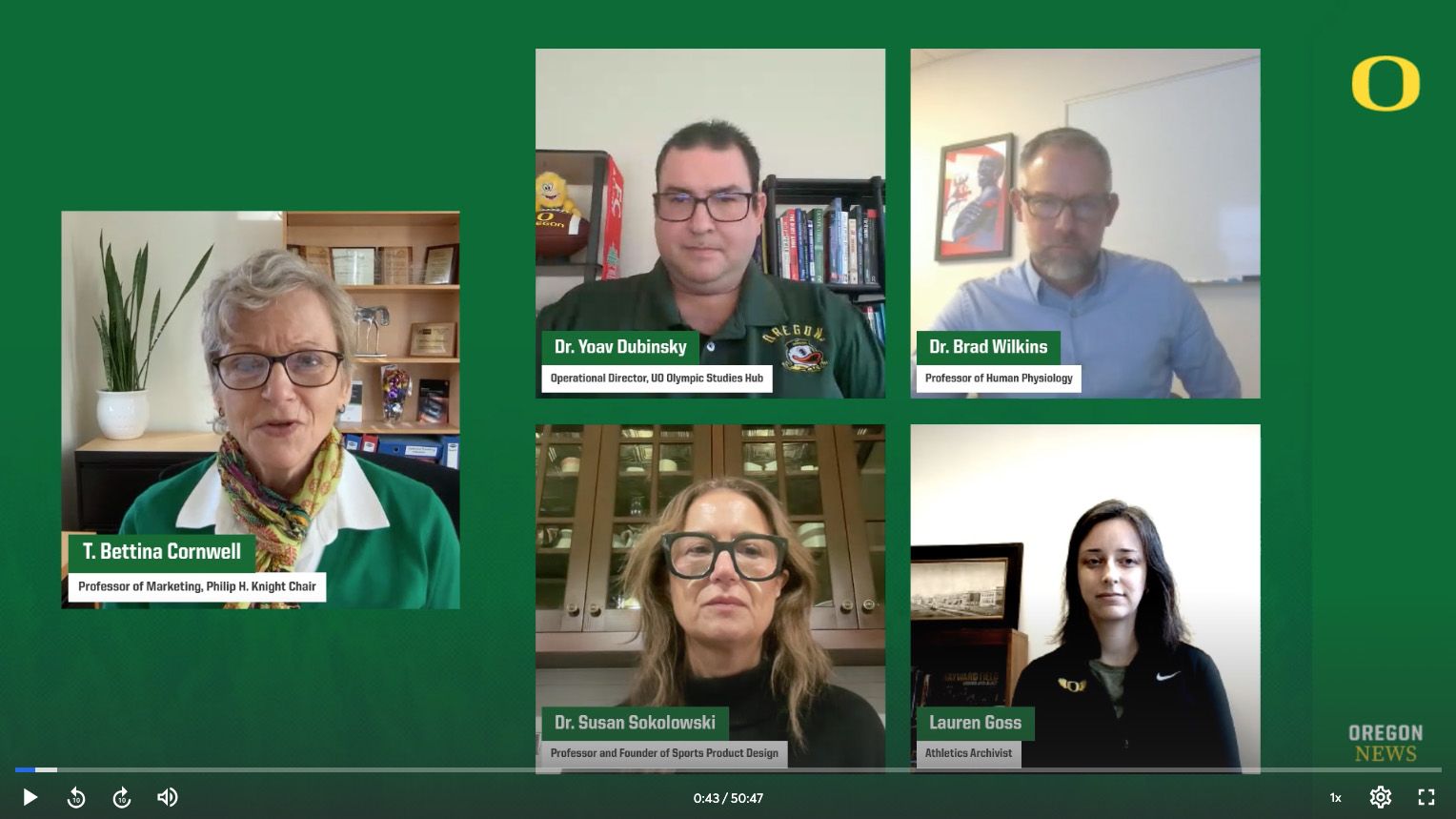Faculty members discussed performance, technology and global issues at the Nov. 7 event
Story by Molly Blancett
November 26, 2025
University of Oregon faculty members offered an interdisciplinary look at the upcoming Milano-Cortina 2026 Winter Olympics during the Fall Media Forum on Nov. 7, covering athlete performance, product design, history and geopolitics.
The event featured five UO experts:
- Brad Wilkins, assistant professor of human physiology and director of the Oregon Performance Research Laboratory
- Susan Sokolowski, professor of product design
- Lauren Goss, athletics archivist in Special Collections and University Archives
- Yoav Dubinsky, associate teaching professor of marketing and operational director of the Olympic Studies Hub
- T. Bettina Cornwell, professor of marketing, Philip H. Knight Chair and academic director of the Olympic Studies Hub.

From left: Brad Wilkins, Susan Sokolowski, Lauren Goss, Yoav Dubinsky and T. Bettina Cornwell
Cornwell opened by noting the distinctive characteristics of the coming Games, calling them "the most geographically spread Winter Olympics we've ever seen," and highlighting the debut of ski mountaineering and the increasing presence of women's events.
Physiology and performance limits
Wilkins emphasized how dramatically winter sports differ in their physical demands.
"The amount of muscle mass used in cross-country skiing or Nordic events is significantly higher (than running) because you're using both your upper body and your lower body, where in running it's just your lower body," he said. "And so there is a lot of sports specificity, meaning that the specific adaptations that the body incurs are directly related to the sport that you are training for."
Designing for winter and adaptive athletes
Sokolowski described the fine line designers walk when preparing athletes for cold-weather performance.
"Winter apparel has to dynamically manage heat and moisture," she said. "Athletes might be freezing while waiting to compete and overheated minutes later."
She also stressed the added complexity for Paralympians.
"Some Paralympic athletes can be cold and hot at the same time," she said. "Impairments can affect heat production, sweat and even temperature perception, so their gear has to be incredibly specific."
Sokolowski said speed suits are engineered with aerodynamic testing in mind.
"Every seam, fabric choice and texture is placed with purpose," she said. "It's all about managing airflow and reducing drag."

Cortina's Olympic legacy
Goss traced the historical arc of Cortina d'Ampezzo, host of the 1956 Winter Games and co-host for 2026.
"The 1956 Games were the first Winter Olympics televised to a multinational audience," she said. "They marked a turning point in how the world experienced the Olympics."
She noted that the Soviet Union's debut in 1956 reshaped competitive dynamics.
"They arrived with a highly organized, state-supported training system and immediately dominated the medal table," she said.
Geopolitics and a decade of mega-events
Dubinsky linked the 2026 Games to broader global trends.
"These Olympics return the IOC to very familiar alpine territory," he said, "but they also introduce an unprecedented, decentralized model meant to reduce cost and increase sustainability."
Dubinsky also pointed to the United States' looming "golden decade" of mega-events.
"Between the 2026 FIFA World Cup, the 2028 Los Angeles Olympics and the 2034 Salt Lake City Winter Games, the U.S. is entering a massive hosting cycle," he said.
But he noted that logistics, visas and security will pose challenges: "Mega-events in the U.S. are a different animal."
Audience questions broaden the conversation
When asked about the return of NHL players to the Olympic tournament, Cornwell said their presence could significantly boost interest and engagement.
"Professional athletes bring their own media ecosystems with them," she said. "That carries straight into Olympic viewership and social impact."
Wilkins addressed how scientists measure elite performance.
"We don't always get direct access to Olympic athletes," he said, "but decades of research let us understand the limits of each sport and apply that knowledge with coaches."
Goss and Wilkins also discussed countries that occasionally break winter-sport expectations.
Referencing the Jamaican bobsled team, Wilkins said, "Sprinters bring the power you need at the start, but the real limiting factor is steering. That's where skill overtakes raw physiology."







